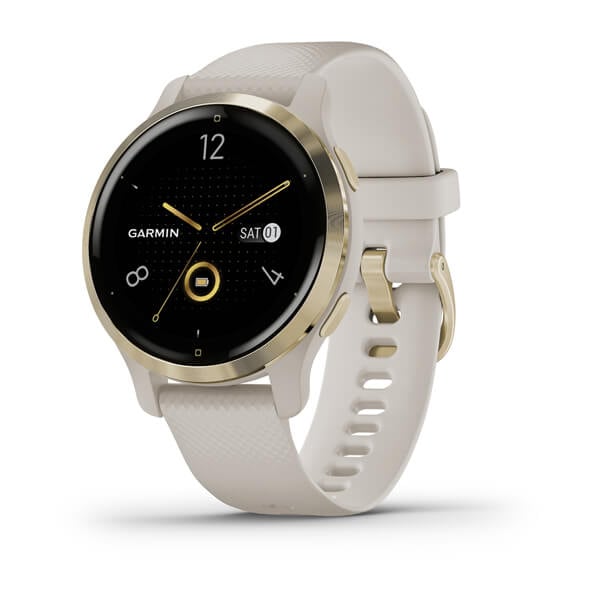
Making the Most of HIIT Workouts with Garmin
By Garmin Ambassador Baylee Rayl
Along with a host of other features, the new Garmin Venu® 2 and Venu® 2S sport activity profiles for HIIT workouts, including preloaded HIIT workouts with on-screen animations and custom timers to help ensure that every second counts. To help you get ready for the new workout opportunities coming to your wrist, Garmin ambassador and CrossFit athlete Baylee Rayl outlines different kinds of HIIT activities, the benefits of each, examples of HIIT workouts and more:
“HIIT” is a term that has skyrocketed in popularity in the past year. But what does it actually mean, and how can it be beneficial for you? HIIT stands for high-intensity interval training. It is any type of workout that alternates between intense segments of activity paired with a fixed amount of less intense activities or total resting time.
HIIT can be programmed in several different formats, like TABATA, EMOMs, AMRAPS and more. For many of us, those formats look like a crazy combination of letters and mostly like gibberish! So let’s break it down a little further and dive into these different types of HIIT workouts:
TABATA
Tabata was created by Dr. Izumi Tabata (hence the name) in Japan. It’s a type of HIIT exercise that applies 20 seconds of work followed by 10 seconds of rest for a set number of rounds. For example, a TABATA workout could look something like this:
In a TABATA workout of sit-ups, push-ups and air squats (20/10×8), one would do 8 rounds of each movement for 20 seconds of work and 10 seconds of rest for a total of 4 minutes of each exercise. Once you’re finished with the first exercise — in this case, sit-ups — you’d move on to push-ups and then air squats. This type of workout allows you to push at a very intense pace while providing 10 seconds of rest for recovery.
EMOM
This acronym stands for “every minute on the minute.” EMOM training means that you will work on a set amount of reps at the top of each minute and then rest for the remainder of the minute. For example, if there are 20 air squats that need to be performed in an EMOM style of workout, those reps would be performed on minute 1. If 20 air squats take approximately 30 seconds to complete, then you will have 30 seconds left to rest until the top of the next minute. An EMOM workout could be styled like this:
20-minute EMOM:
- 20 Air Squats
- 10 Push-ups
- 20 Walking Lunges
- 100-meter Run
On minute number 1, you will perform 20 air squats and then rest the remainder of the minute. On minute number 2, you will complete 10 push-ups and then rest the remainder of the minute. You will continue this pattern until the 20-minute mark, completing 5 rounds of each movement (5 rounds x 4 different minute-long exercises = 20 minutes).
AMRAP
Last up we are going to uncover what in the world “AMRAP” stands for and how it can be modified to be a HIIT workout. AMRAP stands for “as many reps/rounds as possible” in a certain time frame. For example, if a workout is written to look something like this — 20-minute AMRAP of 10 push-ups, 10 sit-ups, 10 air squats and a 200-meter run — you will complete as many reps or rounds of that sequence as you can in 20 minutes. Because AMRAP workouts can tend to get long, the intensity of the workout may decrease. However, AMRAP workouts can also be modified to fit the HIIT profile by adding in some rest. A HIIT-style AMRAP (look at us with all these acronyms) can look something like this:
3-minute AMRAP x 3 (3-minute rest between sets):
- 10 push-ups
- 10 sit-ups
- 10 air squats
- 200-meter run
Essentially, what that means is that you will complete as many rounds/reps as possible in 3 minutes for 3 different rounds and will get a 3-minute rest between each round. With this style, you will work at a high intensity to complete as many reps or rounds of the sequence that you can in the 3-minute window. You will then get 3 minutes of rest between each AMRAP. You will complete this 3 times. Not too complicated when we break it down, huh?
Now that we have evaluated a few different styles of HIIT workouts, let’s dive into WHY these different formats of training might benefit us.
- Efficiency. HIIT is the perfect format for someone on the go or with a tight schedule. With a set work-to-rest ratio, you can plan out exactly how long your workout will take, and you will benefit from the high-intensity aspect of training.
- Minimal or no equipment. For a HIIT style of workout, equipment can be optional. You can add equipment if you would like, but it is not always necessary to get a great workout. Running, biking, body weight movements, etc., are all great exercises to include in your HIIT training, which allows you to take your workouts anywhere you go!
- Challenging. HIIT is HIGH INTENSITY. This means there will be no chatting during your work period — we are pedal to the metal! You will be working hard during your work period, and you will need that built-in rest to recover fully so you can keep your intensity high. These are workouts you can repeat to see how much your fitness has improved.
Ready to give these exercises a test run? Your Venu 2 or Venu 2S comes equipped with preloaded HIIT workouts, and you can open your Garmin Connect™ app for even more you can download. We’ve also provided a few HIIT sample workouts below to help you kick-start your experience.
24-minute TABATA:
For each movement, perform 20 seconds of intense effort followed by 10 seconds of rest. You will complete 8 rounds of ONE movement and then move onto the next movement. You will complete 4 minutes at each movement for a total of 24 minutes.
- Burpees
- Sit-ups
- Air Squats
- Jumping Jacks
- Push-ups
- Walking Lunges
20-minute EMOM:
For each movement, you will complete the required amount of reps at the top of each minute. You will move down the list and perform a different movement at each minute:
Minute 1: 15 Kettle Bell Swings
Minute 2: 12 Alternating V-ups
Minute 3: 15 Push-ups
Minute 4: 20 Air Squats
(Repeat until you get to the 20-minute mark. This will equal 5 total rounds.)
15-minute AMRAP:
This workout includes 3 rounds of 5 minutes each. You will work through the sequence below and get as many rounds or reps in as you can within the 5 minutes. So if you finish the 50 jump ropes, start back at the top with 10 more dumbbell deadlifts and keep going until the time is up. Rest for 2 minutes between each 5-minute round.
10 Dumbbell Deadlifts
15 Box Jumps/Box Step-ups
50 Jump Ropes
We hope you enjoy each of these HIIT workouts — and don’t forget to track them with the new HIIT feature on your Garmin fitness watch!






